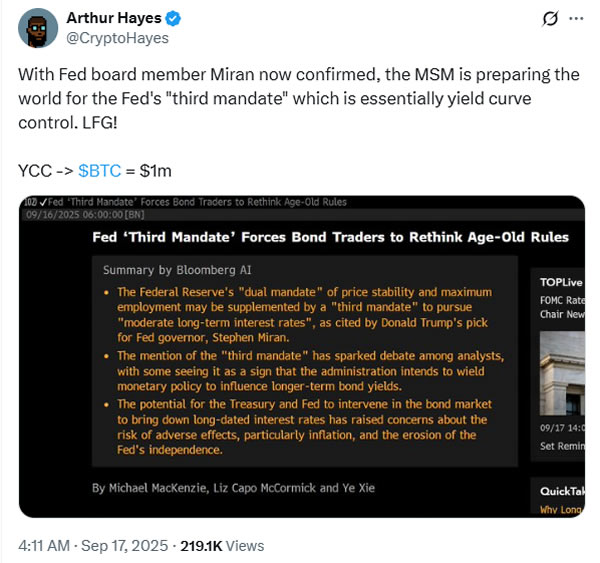The Fed’s “third mandate” requires moderating long-term interest rates; if enacted as yield curve control, it could weaken the dollar and drive capital into Bitcoin as a hedge against monetary expansion.
-
Third mandate cited as legal basis for yield curve control
-
Potential tools include bond purchases, expanded QE, or direct rate pegs to lower long-term borrowing costs.
-
Record U.S. debt ($37.5 trillion) and expert commentary suggest crypto, especially Bitcoin, may benefit if long rates are suppressed.
Third mandate could justify yield curve control; pressuring the dollar and boosting Bitcoin—read COINOTAG analysis and what investors should watch next.
Donald Trump’s latest Fed pick cited a “third mandate” for the bank to moderate long-term rates, potentially justifying yield curve control policies, which could boost Bitcoin.
What is the Fed’s third mandate?
Third mandate refers to the statutory objective in the Federal Reserve Act to promote moderate long-term interest rates alongside maximum employment and price stability. The clause has been largely dormant but now reappears in policy debate as a legal justification for active long-rate suppression.
How could yield curve control or QE under a third mandate affect markets?
Yield curve control (YCC) is a policy where the Fed buys government bonds to cap yields at targeted levels. It directly lowers mortgage and Treasury rates. In practice, YCC or expanded quantitative easing increases money supply and can weaken the dollar versus risk assets.
U.S. national debt stands at roughly $37.5 trillion, raising the fiscal incentive to reduce long-term borrowing costs. Bloomberg reported that officials are revisiting the statutory language as rationale for stronger intervention. Experts quoted in market commentary include Christian Pusateri, who called the move “financial repression by another name,” and Arthur Hayes, who said it could be bullish for Bitcoin.

The 1913 Federal Reserve Act notes a third mandate (highlighted) for moderate long-term interest rates. Source: US Government Publishing Office
Why would this be bullish for Bitcoin?
Front-loaded capital flows often follow monetary expansion. If the Fed pins long rates, investors may seek alternatives to cash and bonds. Bitcoin, perceived by some investors as a hedge against currency debasement and negative real yields, could attract significant inflows.
Market participants point to two channels: (1) reduced yield on safe assets pushes allocation to risk assets, and (2) policy-driven inflation expectations raise demand for scarce, non-sovereign stores of value.
When might investors see tangible effects on crypto prices?
Effects depend on policy timing and scale. Short-term market moves could appear within weeks of a formal YCC announcement. Broader structural shifts—sustained dollar weakness and institutional allocation to crypto—would likely unfold over months.
Structured Data: NewsArticle, FAQ, HowTo
Frequently Asked Questions
How does the third mandate differ from the dual mandate?
The dual mandate focuses on price stability and maximum employment. The third mandate explicitly adds an objective to moderate long-term interest rates, giving legal cover to policies targeting bond yields directly.
Is yield curve control the same as quantitative easing?
Not exactly. YCC pegs or caps specific yields using purchases sized to maintain a target, while QE involves asset purchases without a direct yield peg. Both expand central bank balance sheets, but YCC explicitly targets the yield curve.
What should crypto investors watch next?
Investors should watch Fed guidance, Treasury yield cap talk, U.S. debt trends, and capital flows into Bitcoin. Significant policy moves could trigger reallocation within weeks to months.

Source: Arthur Hayes
Key Takeaways
- Legal basis: The Fed’s statute includes a third mandate to moderate long-term rates, now cited by policymakers.
- Policy tools: Yield curve control, QE expansion, and bond buybacks are possible instruments to suppress long-term yields.
- Market impact: Lower long-term rates and monetary expansion could weaken the dollar and increase Bitcoin demand as an alternative store of value.
Conclusion
The resurfacing of the Fed’s third mandate changes the policy debate by opening the door to yield curve control and more aggressive monetary interventions. For investors, the key signals to monitor are Fed communications, Treasury yields, and capital flows into risk assets like Bitcoin. COINOTAG will continue tracking developments and market responses.







